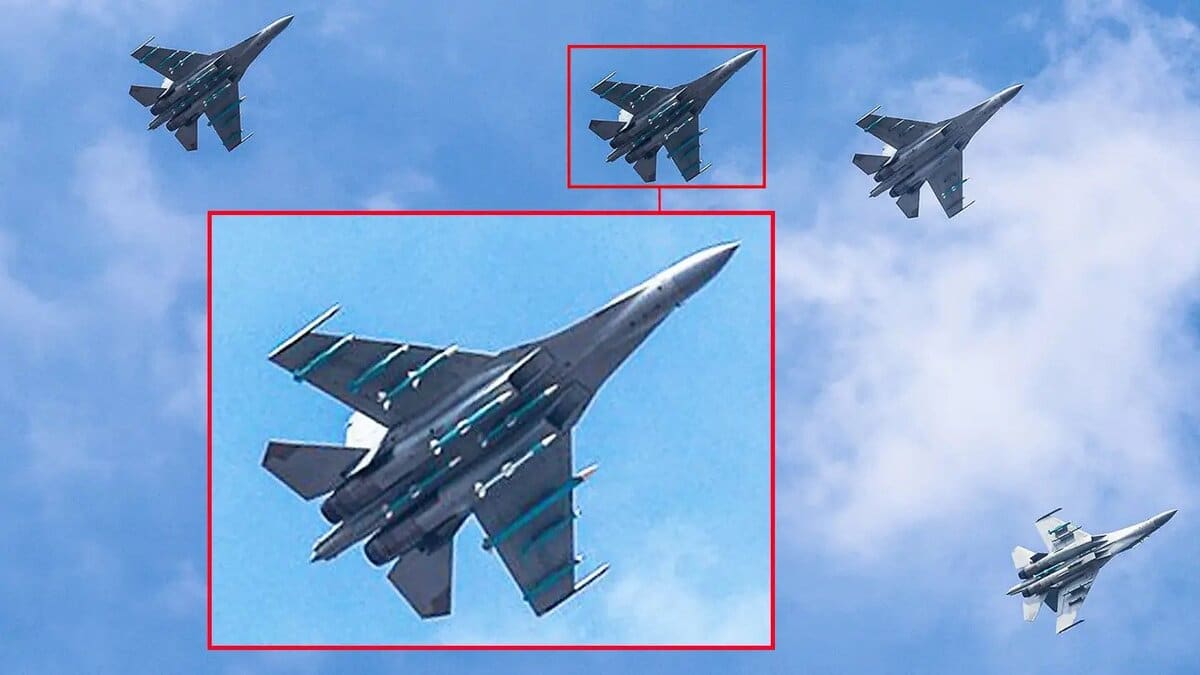 Image Credits: The Drive
Image Credits: The Drive
Recently, a picture of a Chinese J16 fighter surfaced on the internet, showing the jet carrying its full weapon payload capacity in an air-to-air configuration. The J16 is a Chinese variant of the Russian Su30 fighter jets, licensed and manufactured in China for the People’s Liberation Army Airforce (PLAAF).
The jet was shown carrying ten air-to-air missiles, with three on each wing and four on the belly. These missiles showcased prove to be a threat to not just the Indian Airforce, but the US Air Force, as many of these missiles outgun the countries’ mainstay and flagship beyond visual range (BVR) missiles. This picture released is a testament to the rapid growth of the Chinese military industrial complex which has been performing exceptionally. However, this data has come from Chinese authorities and has not been confirmed by the official authorities
China has had an extensive air-to-air missile programme and has come out with the likes of PL 12, PL 15, PL 17 and PL 21, all boasting a range of over 100-150 km proving to be a pain for its two largest adversaries.
PL-2

As indicated the red box, the J16 is carrying a PL-21 missile.
The PL-21 is a ramjet solid fuel missile boasting a range of over 400km. Despite its long range, this missile is only used to shoot down slow-moving targets like AWACS, transporters and mid-air refueling aircraft.
The Indian Airforce lacks an indigenous missile in this similar category, however, it bridges this gap with the help of the Russian R-37, with a range of just shy of 400km. Despite the slightly shorter range, the Russian missile makes do with speeds of Mach 5, flying faster than the PL-21, which only clocks Mach 4.
A more serious scenario is placed with the US, as they retired similar capable missiles decades ago, with the retirement of the F-14 Tomcat. Missiles such as the AiM-154 Phoenix and AiM -152 AAAM come the closest to PL-21, with both having a range of around 200 km, making them the longest-ranged missiles of their time.
PL-15
Boasting a range of 250-300 km, the PL-15 outranges the American AiM-120 AMRAAM and even the Indian-made Astra. The AMRAAM has half the range of the PL-15 with only 160km, whereas the Astra MK-1 has just 110km. However, the IAF has a fix to this problem with the help of the MBDA Meteor which has a similar range of 250-300 km.
This missile can be only launched by Rafales and not any other aircraft in the IAF’s inventory. The IAF only operates 36 Rafales in two squadrons.
PL-12
The PL-12 is a missile which has a range of about 100 km and is the most widely used missile by the PLAAF. Both the Indian and the US airforces can counter this missiles with Astra Mk1 and AiM-120 D missiles, with both these missiles having a greater range.
American programmes
With the rise of the PLAAF, the USAF has been tirelessly developing 5th and even 6th generation technologies to maintain its edge over the Asian giant. Despite making huge leaps with these technologies, it has lost its edge in BVR technologies with Chinese missiles outranging the mainstay AMRAAM.
Taking this into account, the USAF and the Navy with Lockheed Martin are developing the AIM-260 Joint Advanced Tactical Missile (JATM) as a replacement and a supplementary to the AMRAAM. This BVR missile will have a range of over 200km and the F-22 Raptor and the U.S. Navy’s F/A-18E/F Super Hornet are anticipated to serve as the initial launch platforms. Later integration with the F-35 Lightning II and F-15EX Eagle II is envisaged.
Secretary of the Air Force Frank Kendall confirmed before the Senate Armed Services Committee that the JATM is anticipated to arm the Air Force’s future unmanned Collaborative Combat Aircraft and that it will “hopefully” go into production this year.
Indian Programmes
The recent standoffs with the Chinese in the Eastern Himalayas has drawn attention to the extent of the Chinese threat and has acted as a wake up call for the armed forces to shift focus from Pakistan to a bigger and a more well equipped adversary.
Taking this into account, IAF in collaboration with DRDO has conducted a series of tests to not just improve BVR capabilities but to end IAF’s dependance of the Russians, gradually phasing out the Russian BVRs R-77 and R-27.
With this Astra series of missiles came into existence, with Astra Mk1 being tested and integrated with IAF successfully. The Mk1 has a range of 100-120 km with a solid fuel rocket booster. It has a lock on after and before launch capabilities. It was designed to counter the AiM-120C AMRAAM and SD-10 (an export derivative of the PL-12) of the Pakistan Air Force, with both having ranges of around 100 km. This missile has been successfully integrated with Su30 MKi and the LCA Tejas, with integration MiG-29 and MiG29 K underway.
Another two versions of the Astra, i.e Mk2 and Mk 3 are under development and testing with Astra Mk2 completing successful launch trials from a Su30 MKI. This missile will have ranges of around 160 km and will be propelled by a dual pulse rocket motor. The missile is yet to complete more trials and full integration.
The Astra Mk3 is being developed with Russian assistance and will have a range of over 200km. The missile has been tested in its early stages as SFDR (Solid Fuel Ducted Ramjet) and this missile will be able to counter the likes of PL-15 and provide an edge as well.
